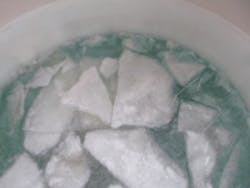January 2014 brought a major weather event to the northern United States and Canada, and many challenges to water utilities in the region. An ultracold mass of air descended out of Canada into the United States, and temperatures fell to record levels. Water utilities struggled with dangerous work conditions, water main breaks and ice formation in water storage tanks. The City of Atwater, Minn.—situated 100 miles west of St. Paul—has seen its share of cold winter weather, but January 2014 set new records.
“We had average temperatures below 0°F for more than a week, and wind chill conditions down to -40°F”, said Steve Bomstad, operator of the City of Atwater water system.
Ice Formation in Tank Creates Maintenance Hassle
Atwater has had a history of problems with ice formation inside its single 100,000-gal elevated storage tank. Ice formation in the 4-ft riser pipe has plugged the tank several times, causing loss of water pressure. When this happens, the utility has to call in a service crew to run a steam loop into the tank to thaw the riser pipe and release the water.
“Usually, we can detect when the riser pipe is becoming constricted by ice because the fill and drain rate starts to drop,” said Bomstad. “If we catch it in time, we can run warm water in and out of the tank and keep the riser from plugging. We also keep the tank water level lower in winter to increase turnover, but this reduces the water reserve we have for fire emergencies. It was a lot of work to deal with this issue.”
Atwater staff had researched various options for reducing the risk of ice.
“We considered passive mixing systems that involved pipes attached to the inlet,” said Bomstad. “But we heard horror stories about these systems being torn off the wall of the tank during severe ice events. We were also concerned about the impact of these permanent systems on tank maintenance.”
Atwater staff also considered insulating the riser pipe, but they were concerned about condensation between the insulation and the riser pipe accelerating corrosion. Utility Service Company, which provides tank maintenance services for the town, suggested using an active PAX water mixer to prevent ice formation and improve water quality during the rest of the year. The PWM100 is specially designed for smaller water storage tanks and, in particular, for eliminating ice formation in these tanks. In late 2013, Atwater installed a PAX water mixer.
Mixer Put to Test
When the “polar vortex” hit Atwater in early January 2014, Bomstad was nervous.
“We had raised the water level in the tank to provide better reserve for fire emergencies, but the cold temperatures and high wind had us concerned,” he said.
Bomstad climbed the tank after several days of subzero conditions and peered inside.
“It was incredible,” he said. “It was big bowl of moving water: it was mixing plenty. I’m very impressed with the mixer’s performance—there’s no ice in the tank. There’s no better test than the last week we had.”
With active mixing now ensuring that ice plugs don’t form in the future, Bomstad plans to run his tank with higher water levels all winter long.
“The previous guys who maintained our water infrastructure did a good job,” he said. “I’m glad I can continue this legacy by protecting this tank from ice damage, and now I have my fire protection back.”



